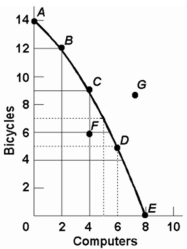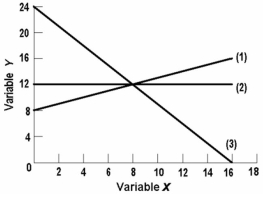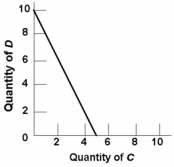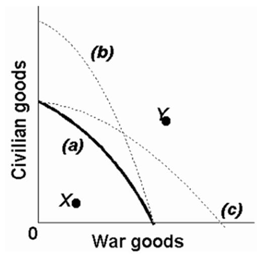A) is based on the law of averages.
B) pertains only to microeconomics.
C) pertains only to macroeconomics.
D) is based upon value judgments.
Correct Answer

verified
Correct Answer
verified
Multiple Choice
If the equation y = 15 - 4x was plotted, the:
A) vertical intercept would be -4.
B) vertical intercept would be +4.
C) vertical intercept would be +9.
D) slope would be -4.
Correct Answer

verified
Correct Answer
verified
Multiple Choice
Economists:
A) always put the independent variable on the horizontal axis and the dependent variable on the vertical axis.
B) always put the dependent variable on the horizontal axis and the independent variable on the vertical axis.
C) are somewhat arbitrary in assigning independent and dependent variables to the horizontal and vertical axes.
D) measure the slope of a line differently than do mathematicians.
Correct Answer

verified
Correct Answer
verified
True/False
Products and services are scarce because resources are scarce.
Correct Answer

verified
Correct Answer
verified
Multiple Choice
In drawing a production possibilities curve we hold constant:
A) the money supply.
B) the consumer price index.
C) both technology and resource supplies
D) resource supplies only.
Correct Answer

verified
Correct Answer
verified
Multiple Choice
The negative slope of the production possibilities curve is a graphical way of indicating that:
A) any economy "can have its cake and eat it too."
B) to produce more of one product we must accept less of another.
C) the principle of increasing opportunity costs does not apply to the economy as a whole.
D) consumers buy more when prices are low than they do when prices are high.
Correct Answer

verified
Correct Answer
verified
Multiple Choice
 -Refer to the above diagram. The combination of computers and bicycles shown by point F:
-Refer to the above diagram. The combination of computers and bicycles shown by point F:
A) is unattainable, given currently available resources and technology.
B) is attainable, but entails economic inefficiency.
C) is irrelevant because it is inconsistent with consumer preferences.
D) suggests that opportunity costs are constant.
Correct Answer

verified
Correct Answer
verified
Multiple Choice
The basic purpose of the "other things equal" assumption is to:
A) allow one to reason about the relationship between variables X and Y without the intrusion of variable Z.
B) allow one to focus upon micro variables by ignoring macro variables.
C) allow one to focus upon macro variables by ignoring micro variables.
D) determine whether X causes Y or vice versa.
Correct Answer

verified
Correct Answer
verified
Multiple Choice
Ben says that "An increase in the tax on beer will raise its price." Holly argues that "Taxes should be increased on beer because college students drink too much." We can conclude that:
A) Ben's statement is normative, but Holly's is positive.
B) Holly's statement is normative, but Ben's is positive.
C) Both statements are normative.
D) Both statements are positive.
Correct Answer

verified
Correct Answer
verified
Multiple Choice
 -The linear equation for line (1) on the above graph is:
-The linear equation for line (1) on the above graph is:
A) y = 8 + 2x.
B) y = 8 + .5x.
C) x = 8 + .5y.
D) y = 8 - 2x.
Correct Answer

verified
Correct Answer
verified
Multiple Choice
The production possibilities curve below shows the hypothetical relationship between the production of capital goods and consumer goods in an economy.
 -Refer to the above diagram. Curve B is a:
-Refer to the above diagram. Curve B is a:
A) production possibilities curve indicating constant opportunity costs.
B) production possibilities curve indicating increasing opportunity costs.
C) demand curve indicating that the quantity of consumer goods demanded increases as the price of capital falls.
D) technology frontier curve.
Correct Answer

verified
Correct Answer
verified
Multiple Choice
At fast-food restaurants:
A) consumers enjoy complete and accurate information.
B) decisions are usually made by trial and error.
C) decisions entail comparisons of marginal costs and marginal benefits.
D) benefits always exceed costs.
Correct Answer

verified
Correct Answer
verified
Multiple Choice
Assume that if the interest rate that businesses must pay to borrow funds were 20 percent, it would be unprofitable for businesses to invest in new machinery and equipment so that investment would be zero. But if the interest rate were 16 percent, businesses would find it profitable to invest $10 billion. If the interest rate were 12 percent, $20 billion would be invested. Assume that total investment continues to increase by $10 billion for each successive 4 percentage point decline in the interest rate. -Refer to the above information. Which of the following correctly expresses the indicated relationship as an equation?
A) i = 20 - 4I.
B) i = 20 - .4I.
C) i = 24 - .4I.
D) i = 20 - 10I.
Correct Answer

verified
Correct Answer
verified
Multiple Choice
Production possibilities tables for two countries, North Cantina and South Cantina:
North Cantina Production possibilities (alternatives)
 South Cantina Production possibilities (alternatives)
South Cantina Production possibilities (alternatives)
 -Refer to the above tables. Suppose that resources in North Cantina and South Cantina are identical in quantity and quality. We can conclude that:
-Refer to the above tables. Suppose that resources in North Cantina and South Cantina are identical in quantity and quality. We can conclude that:
A) South Cantina has better technology than North Cantina in producing both capital and consumer goods.
B) North Cantina has better technology than South Cantina in producing both capital and consumer goods.
C) North Cantina is growing more rapidly than South Cantina.
D) North Cantina has better technology than South Cantina in producing consumer goods.
Correct Answer

verified
Correct Answer
verified
Multiple Choice
Any combination of goods lying outside of the budget line:
A) implies that the consumer is not spending all of his income.
B) yields less utility than any point on the budget line.
C) yields less utility than any point inside the budget line.
D) is unattainable, given the consumer's income.
Correct Answer

verified
Correct Answer
verified
Multiple Choice
Refer to the budget line shown in the diagram below. If the consumer's money income is $20, the: 
A) prices of C and D cannot be determined.
B) price of C is $2 and the price of D is $4.
C) consumer can obtain a combination of 5 units of both C and D
D) price of C is $4 and the price of D is $2.
Correct Answer

verified
Correct Answer
verified
True/False
 -Although sleeping in on a work day or school day has an opportunity cost, sleeping late on the weekend does not.
-Although sleeping in on a work day or school day has an opportunity cost, sleeping late on the weekend does not.
Correct Answer

verified
Correct Answer
verified
Multiple Choice
The following production possibilities table represents an economy which is producing two products, tanks and autos. Refer to the table, in moving from possibility C to D, the cost of a tank in terms of autos is: 
A) 50.
B) 100.
C) 200.
D) 300.
Correct Answer

verified
Correct Answer
verified
Multiple Choice
The term "ceteris paribus" means:
A) that if event A precedes event B, A has caused B
B) that economics deals with facts, not values.
C) other things equal.
D) prosperity inevitably follows recession.
Correct Answer

verified
Correct Answer
verified
Multiple Choice
 -A typical concave production possibilities curve implies:
-A typical concave production possibilities curve implies:
A) that economic resources are scarce.
B) that society must choose among various attainable combinations of goods.
C) increasing opportunity costs.
D) all of the above.
Correct Answer

verified
Correct Answer
verified
Showing 101 - 120 of 261
Related Exams